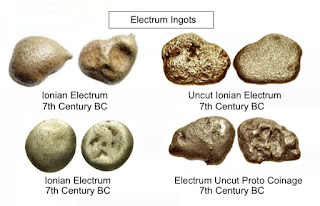It should be noted that any discussion of ancient coinage around 600 BC, when Lehi left Jerusalem and, thus, Nephi’s knowledge of coins, is critically important in understanding the Nephite coinage.
First of all, while there is some debate regarding where the world's first true coin came from, most experts agree that they first appeared in the Ioinan and Lydian regions of Anatolia’s Aegean shore in Asia Minor, which is present-day Turkey. Even though there were well established civilizations like Egypt and Mesopotamia long before that, it wasn't until the 7th Century BC that coins made their first appearance.
Ingots of electrum 7th
century BC, and was the weight 1/6th of a Stater Milesian Standard
Ancient Anatolia electrum contqine3d 70% to 90% gold, as opposed to Lydian electrum, which contained 45% to 55% electrum. Electrum was used as early as the third millennium BC in the Old Kingdom, with the first metal coins ever made were of electrum and date back to the end of the 7th century or the beginning of the 6th century BC.
The earliest coins are mostly associated with Iron Age Anatolia (Asia Minor or Turkey) of the 7th century BC.
It took some time before ancient coins were used for commerce and trade. Even the smallest-denomination electrum coins, perhaps worth about a day's subsistence, would have been too valuable for buying a loaf of bread. According to Herodotus, the first coins to be used for retailing on a large-scale basis were small silver fractions, Hemiobol, ancient Greek coinage minted by the Ionian Greeks in the last half of the sixth century, about 50 years before Lehi left Jerusalem. Some have claimed Lehi was involved in commerce, trading with the camel caravans along the king’s highway, at the base of the hills where Jerusalem was located, and as such, he would have been quite familiar with these first coins, as would Nephi, Sam and Zoram, the latter in charge of Laban’s treasury (1 Nephi 4:20). No doubt, gold and silver coins made up some of Lehi’s treasure left behind (1 Nephi 2:4; 3:22).
Two coins that had wide exposure and usage before Lehi left Jerusalem. Made
of electrum (a naturally occurring alloy of gold and silver with trace amounts
of copper and other metals). Note the shape—oblong and hexagonal—neither are
round
The ancient Bronze Prutah was struck in Jerusalem in the latter part of
the BC era and the early AD period—over time, it had various images and shapes
Another early coin, and was first struck in Jerusalem was the shekel, which was based upon weight, as were the first coins of the modern era minted in the U.S. A biblical shekel weighed 11.33 grams of silver, and in order to calculate the weight of these silver pieces they would put them on one side of the scales and on the other side they placed the beka stone, which was a tiny stone weight engraved with ancient Hebrew letters spelling “beka.” Featuring an ancient Hebrew inscription, the beka weight was used to weigh the annual half-shekel donation Jews brought to maintain the Holy Temple, with the weight used to weigh the half-shekel“one beka per head” of all over the age of 20, which was the cost for each one who went through the counting during the first temple period (1200 to 586 BC), until the temple was plundered by the Neo-Babylonian Empire).
In the second century BC, Rome, as the ruling power throughout the Middle East, operated two mints in the Mediteranean region, one in Lebanon at Tyre, and the second at Antioch. The mint in Tyre produced Tyrian Shekels and Half-Shekels, of a 95% silver purity. In 19 BC, Rome closed the mint in Tyre and began to import an inferior silver coinage from the Far East consisting of 80% pure silver.
The Religious leaders in Israel, realizing that the new coinage was not sufficiently pure to fulfill the Commandment of giving the Holy Half-Shekel, appealed to the Emperor for permission to produce a ceremonial coin of sufficient purity to fulfill their religious obligations. The Rabbanim (governing body of 100 rabbis) received special dispensation to produce the requisite coinage on condition that they continue with the motif of the Tyrian Shekel, so as not to arouse objections within the Roman Empire that the Jews were granted "autonomy" to mint their own coinage.
Tetradachm coins
The coins were the size of a modern Israeli half-shekel and were issued by Tyre, in that form, between 126 BC and 56 AD. Earlier Tyrian coins with the value of a tetradrachm, bearing various inscriptions and images, had been issued beginning in the latter half of the fifth century B.C.
The point is, coins were well known in Jerusalem during Lehi’s time and especially afterward.
(See the next post “What Was the Value and Nature of the Nephite Monetary System? – Part IV” on how Mormon showed us the value of their money)








No comments:
Post a Comment